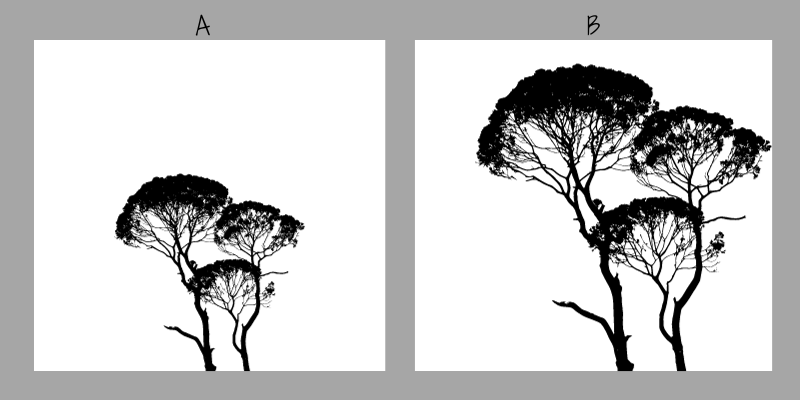
Negative space, also known as the space around and between the objects, can be just as important as the objects themselves. As a painter, understanding the power of negative space can help you create more impactful and balanced paintings. Here are a few ways for utilizing negative space in your paintings.
Create a Sense of Balance
Creating a sense of balance can refer to the visual weight and composition, or it could refer to the need to have some mental space for our minds to be present in the painting. Negative space can help balance the composition of a painting by providing a visual rest for the eye. This is especially useful when working with complex or cluttered subjects.

The image above has the same tree graphic. The only difference is the size and placement. Image B is more powerful looking. It isn’t just the size, it is that the negative space around the tree (the white area) is more effective, than the too large/uninteresting white area of image A.
Direct the Viewer’s Gaze
By strategically placing negative space, you can guide the viewer’s gaze to the focal point of your painting. This can make your subject stand out and create a more impactful composition. For example, when the subject is placed against a large expanse of negative space, you can make it the focal point of the painting and highlight its importance.

Here the skyscrapers lead our eyes up to the sky (hence their names). We don’t even need an extra focal point in the sky (like a bird or a plane).
Creating Tension
While two objects with a lot of space between them will just feel like two objects, if we move them closer, the proximity of the space becomes more apparent. In college, my friend did this very successfully in a painting. She made two people in a painting sit very close together, but not touching. There was a thin line of background between these two people. So very close, but NOT touching. (I even asked if she had this painting twenty years later, because I remember the lesson of it so vividly – unfortunately, she didn’t.) But, I still mention it here because I hope you can visualize the tension created by having two objects or subjects almost touching.

The Creation of Adam by Michelangelo has probably the most famous moment of tension between two figures – the moment just before they touch.
When working with negative space, it’s important to strike a balance between creating enough negative space to have an impact and not leaving so much negative space that the painting feels empty. Experiment with different compositions and see how varying the amount of negative space can affect the overall feel of your paintings.
